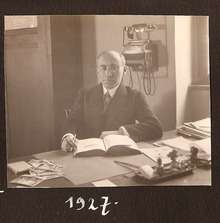Hugo Iltis
| Hugo Iltis | |
|---|---|
 Hugo Iltis in Brno, Czechoslovakia at the Vochshochschule in 1927 | |
| Born |
April 11, 1882 Brno (Brünn), Austria-Hungary |
| Died |
June 22, 1952 (aged 70) Fredericksburg, Virginia |
Hugo Iltis (April 11, 1882, Brno – June 22, 1952, Fredericksburg, Virginia) was a Czech-American biologist.
Life
Hugo Iltis was born April 11, 1882 in Brno, Austria-Hungary. He was the son of the town physician Dr. Moritz Iltis. He became a citizen of the newly established Republic of Czechoslovakia in 1919. His family was of Jewish descent.
He attended the lower grades and the German gymnasium in Brno and then went on to study biology and botany at the University of Zurich, Switzerland from 1900-1903 as an assistant to Arnold Dodel-Port (de)and later Alfred Ernst (the successor of Dodel-Port in 1902). He studied botany at the University of Prague under Hans Molisch (de) from 1903-1905 where he received his Ph.D. in 1905.
In 1906, he was the Secretary for Naturforschender Verein in Brno, which was the society through which Gregor Mendel published his papers. In 1910, he raised funds for the Mendel Memorial in Brno, and was Secretary for the International Committee for the Mendel Memorial. He gave the commemorative speech at the unveiling of the memorial. He was also the Secretary for the Mendel Centenary in 1922, a celebration of the 100th anniversary of Mendel's birth.
He was professor of biology at the Deutsches Gymnasium in Brünn (Brno) from 1905 to 1938, and Privatdozent of botany and genetics in the Deutsche Technische-Hochschule (German Polytechnical Institute) from 1911-1938. He was the founder and director of the Masaryk People's University (Masaryk Volkshochschule) in Brno, an adult education evening school, from 1921 to 1938. The Volkshochschule was the largest institution for adult education in Czechoslovakia with an enrollment above 2000. He founded and curated the Mendel Museum in Brno in 1932 (to 1937). The museum contained many valuable manuscripts and relics of the life and work of Mendel.
A socialist, Iltis spent much of the time from 1930-1938 combating the racist biology (eugenics) of the Nazis.[1]
Iltis emigrated to the United States in 1939 with his wife Anni Iltis and their two boys with the help of Franz Boas and Albert Einstein.[2] His family left behind their life in Brno, and joined him in January 1939 in Cherbourg, France following a harrowing train ride through Germany and France. They left the port Cherbourg, France on the passenger ship Aquitania.
Initially, he taught for 5 weeks at the International School, run by Peter Ray Odgen. Following a chance meeting with Dean Alvey, he was offered a job and became professor of biology at Mary Washington College in Fredericksburg, Virginia where he taught for approximately 12 years.[3] and the founder and curator of the Mendel Museum of Genetics, now housed at the University of Illinois Archives.[4] He died at Fredericksburg, Virginia, on June 22, 1952.[1] His younger son is the plant morphologist and taxonomist Hugh Iltis.[5] His elder son was the entomologist Fred Iltis.
Later in life, to his great surprise, he learned from his wife's sister Lisi Liebscher that his wife Anni Iltis was a distant cousin of Gregor Mendel.
He was a fellow in the A.A.A.S, a member of the Genetics Society of America, the American Genetics Association, the Virginia Academy of Science, and the American Association of University Professors.
He was listed in: Köpfe Europas, Wer Ists, Who Knows What, and American Men of Science.
Works
- Gregor Johann Mendel: Leben, Werk und Wirkung, Berlin: J. Springer, 1924. Translated by Eden and Cedar Paul as Life of Mendel, New York, W. W. Norton & Co, 1932.
- Kampf um den Darwinismus, 1926
- Naturwissenschaft und Sozialismus, 1926
- Volkstümliche Rassenkunde, 1930
- Rasse in Wissenschaft und Politik, 1935
- Der Mythus von Blut und Rasse, 1935. With an introductory article by Iltis, 'Der Rassismus im Mantel der Wissenschaft', and two other articles written by him under a pseudonym.
- "HEMOPHILIA, “THE ROYAL DISEASE”: And the British Royal Family, J Hered (1948) 39(4): 113-116
- The Genes and Academician Lysenko. The Journal of Heredity. Oxford University Press. June 1950
- "An Immigrant Conquers a Continent: The Story of the Wild Garlic." The Scientific Monthly, vol. LXVIII, No. 2, February, 1949.
References
- 1 2 L. C. Dunn, Hugo Iltis: 1882-1952, Hugo Iltis: 1882-1952 Science, Vol. 117 (1953), p.3-4
- ↑ Letter from Einstein to Boas
- ↑ Papers of Hugo Iltis at the Hunt Institute for Botanical Documentation
- ↑ Iltis Mendelania Collection, 1841-1984 - University of Illinois Archives
- ↑ Paul Berg & Maxine Singer, George Beadle, an uncommon farmer: the emergence of genetics in the 20th century, CSHL Press, 2003, p.296